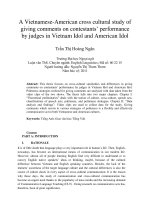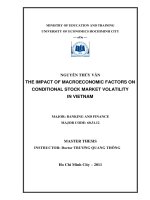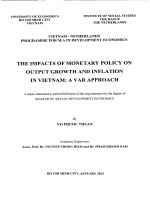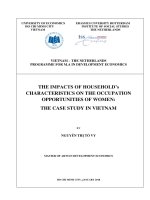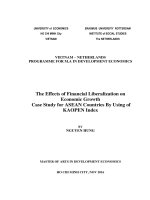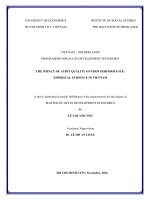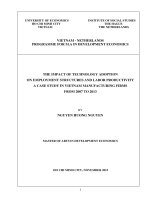The imfact of transaction cost on competitiveness level, case study in vietnam at the provincial level
Bạn đang xem bản rút gọn của tài liệu. Xem và tải ngay bản đầy đủ của tài liệu tại đây (2.28 MB, 83 trang )
UNIVERSITY OF ECONOMICS
INSTITUTE OF SOCIAL STUDIES
HO CHI MINH CITY
THE HAGUE
VIETNAM
THE NETHERLANDS
THE VIETNAM- THE NETHERLANDS PROJECT FOR M.A PROGRAM
IN DEVELOPMENT ECONOMICS
THE IMPACT OF TRANSACTION COST
ON COMPETITIVENESS LEVEL,
CASE STUDY IN VIETNAM AT THE PROVINCIAL LEVEL
"CJ
so GIAO DVC fJAO T,;O
TRVONG 8~1 HQC KINH TE TP.HCM
By
BUI QUANG HUY
THUVIEN
\ ) ·7 6t c:: 0
A thesis submitted in partial fulfillment of the requirements for the degree of
MASTER OF ARTS IN ECONOMICS OF DEVELOPMENT
ACAMEDIC SUPERVISOR:
DR. NGUYEN TRQNG HOAI
HO CHI MINH CITY, APRIL 2008
CERTIFICATION
"I certify that the substance of this thesis has not already been submitted for
any degree and is not being currently submitted for any other degree.
I certify that to the best of my knowledge and help received in preparing this
thesis and all sources used, have been acknowledged in this thesis"
Signature
•
BUI QUANG HUY
•
Date: April 2008
•
I
ACKNOWLEDGMENTS
This thesis is a very significant in my life. And this thesis would not have been
finished without the best helps and supports from many people. So, I wish to
express my acknowledgments to them.
Firstly, I would like to express my acknowledgment and thank to my academic
supervisor, Dr Nguyen Trong Hoai, for his guidance and comments through
#
my thesis writing period. His scientific instructions make my thesis become
.
more clearly and concise.
I sincerely thank Mr Nguyen Duy Khanh, who has provided me to have the
data set of GDP of The General Statistics Office; and Mr Nguyen Anh Tuan
i.
- the expert of the VCCI & VNCI for giving me help in the statistical and
calculation issues of the PCI data for my thesis.
I am very grateful to my teachers and staff in Vietnam -Netherlands Project,
Mr Dao Xuan Due - my leader and friends of mine for their help and
friendship.
.
And finally, as for my family, specially my wife, I can not thank them enough
for their unconditional support and love. They has encouraged and supported
me in during this program.
Ho Chi Minh City, April2008.
II
--- - - - - - - - - - - - -
ABSTRACT
The Transaction cost & Competitiveness include multidimensional feature of
an economic entity operating in a market economy. In this thesis, therefore,
different aspects of them can be explored. The meaning of Transaction cost &
Competitiveness for different economic entities will be determined and their
I
relationship will be shown on the provincial level. The major determinants of
Transaction cost are presented. And, the main objectives of the thesis are
\
firstly, to build a measurement regression model of the Competitiveness level
basing on data which is collected from some resources (The VNCI & VCCI
(2005-2006); General Statistics Office); and then to use that model to evaluate
i
t
the impact of transaction cost on the Competitiveness level. From which,
some important policies can be given so that the transaction cost can be
reduced and the provincial competitiveness in Vietnam can be increased
remarkably
..
·-
•
III
LIST OF ABBREVIATION
Co
Competitiveness
GDP/head or capita
•
•
Gross Domestic Product per head or capita
TC
Transaction cost
HK
Human Capital
QI
Quality of Infrastructure
PM
Proximity to Market
EC
Entry cost
IC
Informal charges
Tc
Time cost of regulatory compliance
TAl
Transparency and access to Information
PSD Pro-activity of Provincial Leadership
X
Time of researching
The VNCI & VCCI
The Vietnam Competitiveness Initiative &
Vietnam Chamber of Commerce and Industry
MICI Microeconomic Competitiveness Index
PIB
Produit Interieur Brut (meaning GDP/head)
SWF social welfare function
OLS Ordinary Last Square
•
VND Vietnamese dong
%
Percent
IV
--------
---------------------------
TABLE OF CONTENTS
CHAPTER 1: INTRODUCTION ....................................................................... !
1.1 Problem statement ....................................................................................... 1
1.2 Research objectives ..................................................................................... 2
1.3 Research questions: ..................................................................................... 2
1.4 Research hypotheses: .................................................................................. 2
•
1.5 Research methodology: ............................................................................... 3
1.6 Research limitation: ..................................................................................... 3
CHAPTER 2: LITERATURE REVIEW .......................................................... 5
2.1 Definitions ................................................................................................... 5
2.1.1 Competitiveness ....................................................................................... 5
2.1. 2 Transaction costs ....................................................................................... 8
2.2 Theoretical backgrounds ............................................................................. 9
2.2.1 The competitiveness model.. .................................................................. 10
2.2.2 Transaction cost model ........................................................................... 14
2.2.3 Human capital, Quality of Infrastructure and Proximity to market: ....... 17
2.3 Empirical studies ....................................................................................... 19
2.3.1 Dale B. Thompson (1998) ...................................................................... 19
2.3.2. Ning Wang (2003) ................................................................................. 25
•
2.3.3 J. Luis Guasch & Alvaro Escribano (2005) ............................................ 26
2.3.4 World Bank (2006) ................................................................................. 28
v
2.3.5 Empirical study of the USAID-funded Vietnam Competitiveness
Initiative (VNCI) and the Vietnam Chamber of Commerce and Industry
(VCCI) (2005-2006) ........................................................................................ 31
2.4 Chapter Remarks ....................................................................................... 31
CHAPTER 3: DATA AND ECONOMETRIC MODEL FINDINGS ......... 34
3.1 The Econometric Design ........................................................................... 34
3.2 The Definition of variables ....................................................................... 35
3.2.1 Dependent Variable (Competitiveness) ................................................. 35
3.2.2 Independent variable .............................................................................. 35
3.2.3 Model specification ................................................................................ 38
f
3.3 Data collection method .............................................................................. 39
3.3.1 Competitiveness ..................................................................................... 40
3.3.2 The determinants of Transaction costs on the Provincial Competitiveness
......................................................................................................................... 40
3.3.3 Variable analysis .................................................................................... 40
3.4 Main hypothesis: ........................................................................................ 46
3.5 Estimation of result by regression equation .............................................. 46
3.6 Explanation of coefficient ......................................................................... 48
3.7 Chapter remarks ........................................................................................ 54
CHAPTER 4: CONCLUSIONS AND POLICY IMPLICATIONS .............. 56
4.1 Conclusions ................................................................................................ 56
4.2 Policy implications ..................................................................................... 57
REFERENCES ................................................................................................... 60
VI
APPEND IX 1 .......................................................................................................66
APPEND IX 2 .•..••••.••..••.••...•........••..••.••..•...••................................••..•..••.•............. 70
APPEND IX 3 ....................................................................................................... 73
APPENDIX 4 ....................................................................................................... 74
f
VII
LIST OF TABLES
Table 2.1: Checklist for the Institutional Transaction Costs Framework 22
Table 2.2: Some Important Types of Transaction Costs .............................. 28
Table 2.3: Transactions Cost Related to the Legal and Regulatory
Environment ...................................................................................................... 29
Table 3.1: Variable summary ........................................................................... 39
Table 3.2: Descriptive statistics of ratio difference of the variable
between 2005-2006 ............................................................................................ 41
Table 3.3: The detail result of Provincial Competitiveness Sub-Indices in
2005 ..................................................................................................................... 43
Table 3.4: The detail result of Provincial Competitiveness Sub-Indices in
2006 ..................................................................................................................... 44
Table 3.5: The results of regression ................................................................ 47
Table 3.6: The results of restricted regression ..............................................SO
•
VIII
CHAPTER 1: INTRODUCTION
1.1 Problem statement
In recent years, globalization has brought new opportunity as well as
challenges to both policy makers and enterprises of Vietnam. In the context of
globalization, regional and international organizations have been established,
growing and setting new standards to influence business activities and various
sectors. It means that the competitiveness improvement becomes one of most
important issue in the economy. So, what is competitiveness? And, why does
competitiveness have important role in economy?
According to the Reports of the National Council for Competitiveness and
Development (2006); Competitiveness, as the ability to maintain and improve
the standards of living in a country, advance the business environment,
strengthen employment, cohesion, environmental protection, and to constantly
upgrade productivity and increase market shares in a globalize context. Thus,
when Vietnam becomes a member of WTO, competitiveness is the key to the
further economic success. Recently, Vietnam's Government focuses on
•
efficiency to enhance the national competitiveness of Vietnam as well as
provinces. That is why more and more Vietnam has become an attractive
destination for foreign investors.
However,
investors
still
complain
about
complicated
procedures
(vietnamnet.vn (2006)). It is because they have to spend a lot of times and
costs for overlapping law, regulation, and bureaucratic official staff. And, they
have to lose a lot of transaction cost before they get anything. So, what is
•
transaction cost? How is its role in modern social? And whether a reduction in
transaction cost and an increase in competitiveness is a really urgent demand?
1
Based on the ideas stated above, the objectives of the thesis are firstly, to
build a measurement model of Provincial Competitiveness and then to use the
model
to
evaluate
the
impact
of
transaction
cost
on
provincial
competitiveness, from which, some important strategies can be given so that
the transaction cost can be reduced and the provincial competitiveness in
Vietnam can be increased remarkably.
1.2 Research objectives
+Measuring the effects of determinants on Provincial Competitiveness.
+ Evaluating and giving conformable policies and strategies that can
improve the Provincial Competitiveness.
1.3 Research questions:
1. What factors will be directly influence to the Competitiveness level?
2. How can these factors affect the Provincial Competitiveness?
3. How has the competitiveness level improved overtime?
4. What the policies that should be suggested to improve the Provincial
Competitiveness?
1.4 Research hypotheses:
1. Whether an increase in Entry cost; Informal charges; Time cost of
regulatory compliance (transaction costs) will give lager negative effect on
the Provincial Competitiveness?
2. Whether an increase in Transparency and access to Information; Pro-
•
activity of Provincial Leadership (transaction costs) will give lager positive
effect on the Provincial Competitiveness?
2
3. Whether a decrease the transaction cost will improve the Provincial
Competitiveness?
4. Is there a positive improvement for competitiveness level in Vietnam
provinces in the two different periods?
1.5 Research methodology:
The main purpose of this thesis is to measure the impact of Transaction costs
on the competitiveness level from 2005 to 2006 (and the case study is in
Vietnam at the provincial level). So, some the data sources will be shown,
such as: the determinants of the transaction cost on the provincial
competitiveness (The VNCI & VCCI (2005-2006)); And the competitiveness
is represented by GDP/capita (General Statistics Office (2002-2005)); After
that they will be checked by the regression double-log econometric model in
this thesis with Ordinary Last Square technique; Besides, the independent
variables and dependent variable of the econometric model will be slightly
analyzed by descriptive statistics and chart basing on the above sources of
data to help this thesis become more richly, clearly and concise.
1.6 Research limitation:
About the economic aspect: The Transaction cost & Competitiveness include
multidimensional feature of an economic entity operating in a market
economy. However, in this thesis is only to focus on measuring the impact of
transaction costs on the competitiveness level, thus it can not evaluate exactly,
specifically and all.
About the data aspect: The determinants of Transaction cost on the provincial
competitiveness only are colleted covered 42 provinces in Vietnam by the
VNCI & VCCI 2005, accounting in total 90% of the national GDP while the
Vietnam includes 64 provinces. This leads that the all other data in 2005-2006
3
only also can be collected basing on these 42 provmces. Besides, the
Competitiveness are measured by GDP per capita. However, the data of
GDP/capita only are taken in General Statistics Office from 2002 to 2005; so,
data of GDP/capita in 2006 for 42 provinces in Vietnam, which will be
calculated by estimation method from the data in 2002 to 2005.
4
CHAPTER 2: LITERATURE REVIEW
This literature review includes three main parts. The first part defines
concepts related to the research such as competitiveness, transaction costs.
The second part is the theoretical backgrounds, as in the competitiveness
model, transaction cost model. The competitiveness has to consider four
problems including transaction costs, human capital, infrastructure, proximity
to markets. The third part introduces different empirical studies in Vietnam
and other countries, which bring about a conclusion of the most significant
variables that can be employed to explain the competitiveness.
2.1 Definitions
f According to the World Bank (2006) the competitiveness for country,
enterprise, and region level can be critically affected by the cost of business
transactions. So in this part, some concepts will be defined to readers to avoid
the confusion of its meanings. It includes competitiveness and transaction
cost.
2.1.1 Competitiveness
The concept of competitiveness has always been subject to a great interest for
both researchers and people involved in practical business because
competitiveness is a multidimensional feature of an economic entity that
operates in a market economic performance. So, in the recent studies it has
become widely used the term in economic literature. However, wide and
frequent usage of the term is not always based on the clearly defined contents
of the word, and this cause a lot of misunderstanding and contradiction based
on terminological non-exactitude. In this study, it should be considered some
concepts clearly & focus on various aspects of competitiveness as:
5
According
to
Porter
(1990);
Trabold
(1995);
and
Garelli
(1997),
competitiveness reflects a position of one economic entity (country, region,
industry, enterprise ... ) in relation to other economic entities by comparing the
qualities or results of activities reflecting superiority or interiority and
competitiveness can be defined both in a narrower and in a broader sense:
+ In a narrow approach, the competitiveness is explored in conditions
where entities' interests are contradictory (achievement of the aim by one
entity would make it impossible for another entity to execute its interests).
+ In a broader approach to the concept encompasses also the indirect
and potential competition between entities, analyzing the areas where
entities' direct interests are not contrary.
Broader approach makes competitiveness analysis similar to the comparative
analysis in its most general meaning. Positive feature of such a general
approach would be emphasizing the importance of the method of comparison
in evaluating entity's qualities and activities. Any quality or performance can
be thoroughly evaluated only in comparison with similar entities. However,
too general competitiveness analysis would leave the establishment and
execution of concrete managerial tasks obscure.
More specific competitiveness analysis (narrow approach) would determine
the confrontation of interests and thereby find the solutions to overcome
contradictions. In operative management emphasis is put on direct conflicts on
markets and use of operative means to win the competition. Strategic
management encompasses also the analysis of indirect and potential
controversies that are likely to occur in the future and the ways to solve them.
6
Competitiveness is "the ability to provide products and services as or more
effectively
and
efficiently
than
the
relevant
competitors"
(The
Competitiveness Institute (2007)).
According
to
the
National
Competitiveness
Council
(2007),
The
Competitiveness is the ability of a country to achieve sustained high rates of
growth in GDP per capita.
The concept of competitiveness m Vietnam (The VNCI & VCCI (2005,
2006)), it is determined by the productivity and quality of the business
environment between the provinces together. They can present the factors
used to measure the competitiveness as Entry Costs, Access to land,
Transparency and access to information, Time costs of regulatory compliance,
Informal Charges, State sector bias, Pro activity of provincial Leadership,
Private sector development policies, Labor training, Legal institutions .
According to Porter (1998), he used common determinants analysis to create a
Microeconomic Competitiveness Index (MICI).
Many determinants of the
microeconomic environment tended to move together.
He explored the
relation between a nation's score on MICI and its relative GDP per capita and
found a strong correlation. Thus, in this thesis; The concept of competitiveness
is ability to create business environment clearly to attract investment from
different resources in region as a province, can be related to the GDP per
capita of the region and it is reflected by many factors as transaction cost:
area' economic policy, development level (human capital), quality of
infrastructure, distance to main markets .
•
7
---- ---------------------------
2.1.2 Transaction costs
It's easy to understand about the basic concept of transaction cost that are
those costs of buying and selling in markets which are not passed on in the
transaction.
According to Ronald Coase (1937.p.388), the definition of transaction cost
introduced as "cost of using the price mechanism" is based on the notion of
the costliness of exchange and the recognition of information as scarce and
valuable asset. Another definition of transaction cost by Arrow (1969. p.48)
"transaction costs are the costs of running the economic system". Both
definitions imply that transaction costs are costs that it includes the direct and
indirect costs of making the products, such as the costs of labor, energy, raw
materials, semi-manufactured products, components, depreciation of the
machinery, and maintenance.
Besides, Williamson (197 5) uses the concept of transaction cost market
imperfection in his analytical framework. Transaction cost economics focuses
on the most efficient governance structure for a given type of transaction. A
transaction is defined as the transfer of a good or service across a
technologically separable interface (Williamson, 1985). A "most efficient"
governance structure means that the total cost of production and transaction
are, in the long term, less than those of any other governance structure. So,
transaction costs are the costs connected with finding a contractual partner,
specifying a contract, and securing that the ex-ante defined goals will be met
ex-post.
In addition, transaction costs are the time, effort, and money necessary,
including such things as commission fees and the cost of physically moving
the asset from seller to buyer, and transaction costs should also include the
8
bid/ask spread as well as price impact costs (for example a large sell order
could lower the price). It can include: round-trip transactions costs,
information costs, search costs (The Free Dictionary, 2007). So, nowadays, the
concept of transaction costs are determined by fee on transaction, which often
paid for the acquisition and management of information, searching costs,
bargaining costs, policing costs, enforcement costs ...
However, in this thesis; we only remind and limit the concept in sphere from
Government to Business. It means that, we measure the impact of transaction
costs on new institutional economics (public services and public policies); and
the concept of transaction costs are costs (include direct & indirect cost) in
business environment of every province as Entry cost (EC); Transparency and
access to Information (TAl); Time cost of regulatory compliance (Tc);
Informal charges (IC); Pro-activity of Provincial Leadership (PSD); because
they are considered to be important factors and therefore they are chosen as
the unit of analysis in this thesis research.
2.2 Theoretical backgrounds
For the region, according to The Competitiveness Institute (2007), the
competitiveness level is the ability of the region's people to achieve a high
and rising standard of living. Almost region, the standard of living is
determined by the productivity with which the region's resources are deployed
as the output of the economy per unit of labor and/or capital employed. A high
and rising standard of living for all the region's people only can sustained by
continual improvements in productivity, either through achieving higher
productivity in existing businesses or through successful entry into higher
productivity businesses. Thus, the competitiveness level is measured by the
level and growth of the region's standard of living, the level and growth of
9
-- - ---------- -------- ---
aggregate productivity, and the ability of the region's firms to increase their
penetration of world markets through exports or foreign direct investment So,
it can relate to Transaction costs, Economic performance, Government
efficiency, Business environment efficiency.
However, in this thesis, to measure the problems of competitiveness, it should
only be presented and limited in sphere of some main factors that can
measured, such as: transaction costs, human, infrastructure, proximity to
markets. As the competitiveness, the transaction costs also include the same
the some factors: Business environment efficiency, Public institutions - Law,
Entry costs, Time costs, Management ... to measure ability to attract investment
and increase the competitiveness of province. It means that an entity makes
systematic efforts to improve its qualities and performance in order to
improve its competitive position. The result of its activities depends on to a
great extent on the other entities' performance and on the impact of objective
factors that determine competitive environment.
2.2.1 The competitiveness model
According to Porter (1990), the traditional model, competitiveness 1s
determined by the productivity, can be related to some factors (determinants)
such as human resources, new knowledge and technologies, capital.... This
Porter's theory of competitiveness has had powerful implications for the way
in which governments, organizations and firms in developed, transition, and
developing countries have pursued competitiveness. In addition, according to
the World Bank (2006) the competitiveness of a firm or a region can be
critically affected by the cost of business transactions. In this literature, it has
been mentioned and also measured competitiveness of business environment
based on analysis of transaction costs, which focuses on the extent to which
10
---.......-------- -
-
.
the private sector incurs unnecessary transaction costs that make it unable or
unwilling to invest and compete domestically and internationally. Elevated
transaction costs could originate from excessive regulation and/or inefficient
and corrupt government enforcement of regulations, excessive costs of
infrastructure services, poor contract enforcement, and unfair and lengthy
conflict resolutions. It means that competitiveness hasn't only relationship
with transaction costs but also some factors of the productivity as human
resources, new knowledge and technologies, physical capital.
Through the above literatures, it can be concluded that competitiveness 1s
depending on:
Competitiveness
=f(Transaction costs, Human resources, New knowledge
and Technologies, Physical Capital)
(2.1)
Besides, according to the score of competitiveness (presented in World
Competitiveness Scoreboard (WCS)) computed by the International Institute
for Management Development (IMD) in Geneva takes into account four
determinants such as economic performance, government efficiency, business
efficiency, and infrastructure. Each of them is divided into five sub factors
which emphasize the fundamental aspects of the domain under analysis, as
follows:
Economic performance would be performed by the health and stable level of
domestic economy, international trade, international investment, employment,
and prices.
Government efficiency can be included public finance, fiscal policy,
institutional framework, business legislation, societal framework.
Business efficiency can be included productivity, labor market, finance,
management practices, attitudes and values.
11
- - - -- ---------
Infrastructure
can
be
included
basic
infrastructure,
technological
infrastructure, scientific infrastructure, health and environment, education.
Through the above analysis, it shown that competitiveness relates to in total
twenty determinants which is divided into five sub factors, however it can be
•
observed that competitiveness with following main factors:
Co
=
f(Economic
performance,
Government efficiency, Business
efficiency, Infrastructure).
(2.2)
Although, all above theories are not complete but they present only the most
important links between the different instruments and the involved
competitiveness level. Based on this theory and purpose of this study, it can
be selected some main factors and only focused to measure competitiveness
among different regions.
From the 2.1 & 2.2 models, therefore Competitiveness can be expressed as a
following function:
Co
= f(Transaction costs, Human resources, Infrastructure, Government
efficiency)
(2.3)
But, that the one of most important we can't ignore in this theory is the most
general indicator of regional competitiveness, which is ability to earn, can be
.
related to the GDP per capita (Poter, 1998). Besides, with that sense,
according to Gardiner (2003), the competitiveness, as measured by GDP per
capita, which can be depended on many factors because the GDP per capita is
considered to be the best representation of the productivity. It may be broken
down in more factorial components, each having its own economic
interpretation (Gardiner, 2003):
12
GDPicapita = GDP/Total Population= (PIB 11 Total number of hours worked)*
(Total number of hours worked I Employment) * (Employment I Working age
population)* (Working age population I Total Populationf
(2.4)
So, we have a function of competitiveness:
GDP/capita = f (Transaction costs, Human resources, Infrastructure,
(2.5)
Government efficiency)
1
PIB is GDP which can be translated by French (Produit Interieur Brut)
2
The regional implications of considering the total number of hours worked are more eloquent in this case than at
national level. Regions may present a more important specialization from sectorial viewpoint (for example: agriculture),
making the adjustment based on various characteristics of hours worked represent more accurately the real working
effort involved in producing the output in comparison with the measured one.
13
2.2.2 Transaction cost model
According to Coase (1937, 1961) original formulation of transaction costs,
refer to "the cost of using the price mechanism" or "the cost of carrying out a
transaction by means of an exchange on the open market". As Coase (1961. p.
15) explains, "in order to carry out a market transaction it is necessary to
discover who it is that one wishes to deal with, to inform people that one
wishes to deal and on what terms, to conduct negotiations leading up to a
bargain, to draw up the contract, to undertake the inspection needed to make
sure that the terms of the contract are being observed, and so on". However,
at that time, his these theories are limited, which only focus to solve certain
economic tasks by firms and when they would be performed transaction
clearly on the market (fixed cost).
Arguably, transaction cost reasoning became most widely known through
Oliver E. Williamson's Transaction Cost Economics (1975, 1985, 1996, 1998,
2000). Transaction costs seem important for economic development. Wallis
and North comment on their results that: " ... throughout history, the costs of
transacting may have been as much a limiting factor on economic growth as
transformation costs" (Wallis & North, 1987. p. 121). According to them, there
are two kinds of TC:
1. Ex ante costs of drafting, negotiating, and safeguarding an
agreement. In the case of partnerships, these costs arise at the beginning.
2. Ex post costs that emerge when a contract's execution is misaligned
with the costs of running the economic system, as a result of gaps, errors,
•
omissions, and unanticipated disturbances. In the case of partnerships, these
costs occur during the partnership's lifespan.
14
Ex ante costs can be further divided into search costs and contracting costs.
For partnerships, search costs include the costs of identifying and evaluating
potential partners. Contracting costs are associated with negotiating and
writing an agreement between partners. These costs occur mostly before the
partnership formally begins (Wallis & North, 1987)
Ex post costs can be divided as well into monitoring and enforcement costs.
Monitoring costs are associated with monitoring the agreement to ensure that
each partner fulfills the predetermined obligations. Enforcement costs are
associated with ex post bargaining (renegotiation) and sanctioning a partner
that does not perform according to the agreement (Wallis & North, 1987). In
this theory also has some limitations because it still focuses on partnership
performance, it means that from Business to Business, while transaction costs
inherent to the market mechanism are also relevant to instruments designed in
order to correct market failures.
Until, in recently, the literature on institutions (law, financial markets, trust,
social capital, corruption, etc.) and economic growth are another body of work
that involves proxy measurement of transaction costs as broadly understood
(e.g., Besley 1995; Knack and Keefer 1995; Hall and Jones 1999; Acemoglu
et al2001; see Lin and Nugent 1995; Rodrik 2000; the World Bank 2002). The
primary contribution of this body of work is to demonstrate empirically and
systematically the simple point that institutions do matter for economic
development (Matthew, 1986). In these theories describe that transaction
costs include direct costs & indirect costs as fixed costs, negotiation costs,
information costs, uncertainly costs (property right, contracts), transfer fees,
taxes, distributive costs, contextual costs, institution costs, execution costs,
opportunity costs. Besides, according the VCCI & VNCI (2005, 2006),
transaction costs also are included & measured as Entry cost; Transparency
15
and access to Information; Time cost of regulatory compliance, Informal
charges,
Pro-activity
of
Provincial
Leadership,
Access
to
land,
Implementation and consistency of policies, private sector development
policies, legal institutions..... All the previously mentioned types of costs can
most probably be divided into 'variable' transaction costs, in the sense that
they depend on the volume or number of certain transactions and into 'fixed'
ones.
Although, all above theories are not complete, but they also present the most
important links between the different instruments and the involved transaction
costs. Based on this theories, and the limited of this study, so this thesis only
can be selected by some main factors to influence competitiveness and now
which has been related to GDP per capita and it can be only focused to
measure the effects of transaction costs on public policy (Government to
Business & vice versa).
Therefore transaction cost can be expressed as a function of some factors:
TC = k (EC, TAl, Tc, IC, PSD)
(2.6)
Where: Transaction cost (TC) and Entry cost (EC); Transparency and access
to Information (TAl); Time cost of regulatory compliance (Tc); Informal
charges (I C); Pro-activity of Provincial Leadership (PSD)
On the other hand, Transaction cost economics can applied to the transactions
required development and sustain the attributes of competitiveness. Another,
Wallis and North estimated that transaction costs amounted to one half of the
Gross Domestic Product. (Wallis & North, 1987)
From the 2.3 & 2.6 models, therefore, the Competitiveness can be regressed
as a function of transaction costs:
Co= f (EC, TAl, Tc, IC, PSD)
(2.7)
16


